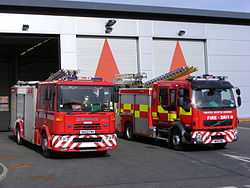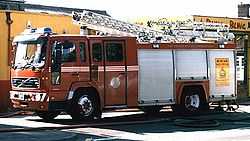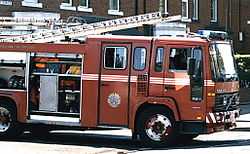Tyne and Wear Fire and Rescue Service
| Tyne and Wear Fire and Rescue Service | |
|---|---|
| Operational area | |
| Country |
|
| County |
|
| Agency overview | |
| Employees | 1,151 |
| Chief Fire Officer | Tom Capeling |
| Facilities and equipment | |
| Stations | 17 |
| Website | |
| Official website | |


Tyne and Wear Fire and Rescue Service, formerly Tyne and Wear Metropolitan Fire Brigade, is the statutory fire and rescue service for the metropolitan county of Tyne and Wear. The service provides emergency fire cover to the five comprising metropolitan boroughs of Sunderland, Gateshead, Newcastle Upon Tyne, North Tyneside and South Tyneside, serving a population of 1.09 million people and a total geographical area of 538 square kilometres.[1] Tyne and Wear Fire and Rescue Authority is responsible for the running of the service, as well as the publication of performance indicators in accordance with its legal obligations.[2] In February 2012, Tom Capeling was appointed Chief Fire Officer of the service after his predecessor, Iain Bathgate, retired after serving four years in the position.[3]
History
Tyne and Wear Fire and Rescue Service was established as Tyne and Wear Metropolitan Fire Brigade in 1974 as a result of changes to area boundaries within the north east of England. Essentially, a fire service did exist through delivery of several smaller fire services established under the Fire Brigades Act 1938 which made it a requirement for local authorities to provide fire cover to their area,[4] although the smaller services were never united as one service as they are today until 1974. During the second World War, all local fire services in the region and on a national level created under the 1938 legislation were nationalised to form the National Fire Service, remaining this way until the Fire Services Act 1947 which handed control back of fire cover back to local authorities in 1948.[5][6] When the service was established in 1974, it brought together four small local fire services and parts of two others to form the service that exists today.[5]
In June 2003, then Deputy Prime Minister John Prescott submitted a white paper to Parliament outlining reforms to the Fire Service in the UK. Part of the reforms outlined included changing the name of fire services across the UK to 'Fire and Rescue Service', giving greater emphasis to the changing role of the fire service.[7] In 2004, following further government publications, the name of the service was changed from Tyne and Wear Metropolitan Fire Brigade to Tyne and Wear Fire and Rescue Service,[5] with post-2004 vehicle livery and all other parts of the service reflecting the name change. In 2006, the service had built six new fire stations under the Public Private Partnership initiative, replacing older fire stations that were in need of extensive upgrade; the service had also built a new headquarters in Washington to replace the previous headquarters on Pilgrim Street in the centre of Newcastle as well as a new Technical Services building.[8] In 2011, the location for the new Sunderland North fire station in Fulwell was announced, with the station expected to be opened in late 2014 and replacing the current station nearby.[9]
Overview
The Tyne and Wear Fire and Rescue Service serves over one million people in Sunderland, Newcastle and Tyneside.[10] The service responded to 24,025 incidents in the period 2004 to 2005, which consisted of 13,060 fires, 8,495 false alarms and 2,470 special service calls. Of its 15 wholetime, one part-wholetime/part-retained, and one retained fire stations, the FRS operates 48 frontline fire appliances consisting of:
- 31 Pumping Appliances
- 2 Aerial Ladder Platforms (ALP)
- 1 Turnable Ladder (TL)
- 1 Emergency Tender (ET)
- 1 Incident Response Unit (IRU)
- 1 Operational Support Unit (OSU)
- 1 Special Rescue Tender (SRT)
- 1 Command Support Unit (CSU)
- 1 Boat Transporter (BT)
- 1 Fireboat
- 1 DIM Unit
- 6 Prime Movers
- 5 Urban Search and Rescue (USAR) Pods
- 2 High-Volume Pump Unit Pods
- 1 Decontamination(Decon.) Dis-Robe Pod
- 1 Decontamination(Decon.) Re-Robe pod
Fire stations
There are currently seventeen fire stations in operation with the Service. From 1 July 2009, the names of the fire stations were changed, 'to provide consistency throughout the Service and to support the introduction of national callsigns'. The table below shows the former and current names for all seventeen stations:[11] All fire stations are staffed on a wholetime basis with the exception of the Gateshead West Fire Station.[12]
| Station radio callsign | Station current name | Station former name | Appliances | Address | Area |
|---|---|---|---|---|---|
| A | Newcastle West/Fire Safety North | West Denton | 3 | West Denton Way | Newcastle |
| C | Newcastle South | Colby Court (Newcastle Centre) | 3 | Elswick Road | Newcastle |
| E | Newcastle North | Gosforth | 2 | Jubilee Road | Newcastle |
| F | Newcastle East | Fossway | 5 | Union Road | Newcastle |
| G | North Tyneside South | Wallsend | 2 | Hadrian Road | North Tyneside |
| H | Sunderland South | Rainton Bridge | 1 | Mercantile Road | Sunderland |
| J | North Tyneside East | Tynemouth | 2 | Preston North Road | North Tyneside |
| K | South Tyneside East | South Shields | 4 | John Reid Road | South Tyneside |
| M | Sunderland North | Fulwell | 2 | Station Road | Sunderland |
| N | Sunderland East/Fire Safety South | Railway Row | 2 | Railway Row | Sunderland |
| Q | Sunderland Central | North Moor/Farringdon | 2 | Northmoor Road | Sunderland |
| S | Sunderland West | Washington | 2 | Glover Industrial Estate | Sunderland |
| T | South Tyneside West | Hebburn | 3 | Victoria Road West | South Tyneside |
| V | Gateshead East | Gateshead | 4 | Dryden Road | Gateshead |
| W | Gateshead South | Birtley | 2 | Durnham Road | Gateshead |
| Y | Gateshead North | Swalwell | 2 | Market Lane | Gateshead |
| Z | Gateshead West | Chopwell | 1 | Derwent Street | Gateshead |
Other facilities
The Technical Services Centre is located at Baltic Road in Gateshead.
The Control Room is also located at the services Headquarters after moving from Newcastle West Denton.
The Barmston-mere Training Centre and the Service Headquarters are also located in Sunderland at Nissan Way. The Service Delivery Headquarters is located at Railway Row.
Dennis/Volvo fire appliances
Originally TWFRS Dennis Specialist Vehicles, efficient for fire service use. Over time the service depended less on Dennis appliances and more on Volvo. In recent years it has begun to use more Dennis appliances and it is currently a variation of Volvo and Dennis appliances. Now the brigade a going back to Volvo, with 17 new pumps & and new aerial ladder platform on order. The new aerial ladder platform is likely to replace the turntable ladder at Foxtrot, and 3 new operational support units are coming to replace the current operational support unit at Gateshead, the emergency tender at Colby Court and the special rescue tender at Hebburn.

_Operational_Support.jpg)
Community fire stations
The intention of community fire stations is to use them as meeting places to discuss fire related issues, as well as offer facilities for local citizens to receive fire safety information if should they require it. Another aim of the community fire stations was to "Provide the community with the highest standards of fire safety and firefighting services available" A lot of the community fire stations now have YFA (Young Firefighters Association) which allow children to experience what it would be like to be a firefighter and what work and effort is involved.[13]
During the 1980s and early 1990s - the brigade used the "welephant" character to publicise it’s fire safety scheme amongst schoolchildren. As well as visiting schools, the character (usually an officer dressed up inside the giant red elephant costume) visited supermarkets and towns across the brigade’s patch highlighting the message during the school holidays.
Changes to the fire service
Over the next few years the service will be buying new fire appliances and building several new fire stations. There are currently plans to replace one community fire station in Tynemouth and the future of Fulwell is currently being investigated (i.e. refurbishment, re-location or rebuilding on same site). The emergency tender based at Sunderland Central Fire Station ended its service in March 2007. 2 new high volume pump unit pods have been acquired by the FRS.
See also
- Fire apparatus
- Fire service in the United Kingdom
- Fire station
- FiReControl
References
- ↑ "About Tyne and Wear Fire and Rescue Service". Tyne and Wear Fire and Rescue Service. Retrieved 11 March 2012.
- ↑ "Tyne and Wear Fire and Rescue Authority". Tyne and Wear Fire and Rescue Service. Retrieved 11 March 2012.
- ↑ "Fire and rescue service appoints new Chief Fire Officer". Tyne and Wear Fire and Rescue Service. Retrieved 11 March 2012.
- ↑ "Division within HO: Fire Service Department". The National Archives (United Kingdom). Retrieved 19 March 2012.
- ↑ 5.0 5.1 5.2 "History of Tyne and Wear Fire and Rescue Service". Tyne and Wear Fire and Rescue Service. Retrieved 19 March 2012.
- ↑ "Timeline: 1248 to 1967". Tyne and Wear Fire and Rescue Service. Retrieved 19 March 2012.
- ↑ "Our Fire and Rescue Service". Office of the Deputy Prime Minister. Retrieved 19 March 2012.
- ↑ "Community Fire Stations". Tyne and Wear Fire and Rescue Service. Retrieved 19 March 2012.
- ↑ Wheeler, Katy (1 August 2011). "Site of new Sunderland fire station revealed as Fulwell base prepares to close". Sunderland Echo. Retrieved 19 March 2012.
- ↑ coverage area by TWFRS Retrieved on 1 June 2007
- ↑ TWFRS: New Station Names
- ↑ http://www.twfire.org/about/locations/new-station-names/#.Uul2BDaA3cs
- ↑ " Community fire stations-purpose Retrieved on 31 January 2007
External links
| Wikimedia Commons has media related to Tyne and Wear Fire and Rescue Service. |
- Official website
- Official Site of the FIRE KILLS: YOU CAN PREVENT IT! Campaign
- Fire Gateway Website, Fire Safety Information and Fire Service locater
Video clips
| ||||||||||||||||||||||||||